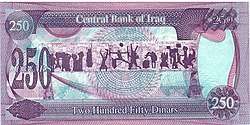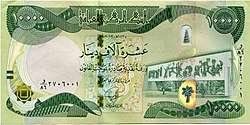Freedom Monument (Baghdad)
| نصب الحرية | |
 Freedom Monument at night, Baghdad in 2017 | |
| Location | Liberation Square, Bab Al-Sharqi |
|---|---|
| Designer | Jawad Saleem |
| Material | Concrete, Bronze |
| Height | 10 meter |
| Beginning date | 1958 |
| Completion date | 1961 |
Freedom Monument (or Nasb al-Hurriyah) (Arabic: نصب الحرية), located in Tahir Square (Liberation Square) in the centre of Baghdad, is the city's most well-known and well-loved monument.
Background and History
The monument was commissioned in 1959, shortly after Iraq gained independence. Iraqi's leading sculptor, Jawad Saleem, who was well-known for works that integrated Iraq's ancient history with contemporary themes and techniques was commissioned by the new leader of the republic, Brigadier General 'Abd al-Karim Qasim, who wanted to create a monument that would be a celebration of Iraq's declaration of independence. It was to be situated in the heart of Baghdad's central business district, overlooking Liberation Square and Jamhouriyya Bridge. The sculptor understood that the monument would need to be a symbol of a new nation state, and designed a work that was more than a simple narrative of the 1958 revolution, but that also paid homage to Iraq's deep art history by including Abassid and Bayblonian wall-reliefs, producing a sculpture that was both "strikingly modern" yet also referenced tradition.[1]
Saleem laboured on the project under difficult conditions, resisting all attempts by Qasim to have his image incorporated into the monument.[2] Initially, Saleem had wanted the sculpture to be at ground level, but the project architect, Rifa'at Chadirchi, insisted that it be elevated so that it would look more 'monumental'. As a result, the completed work faces the busy traffic rather than people walking in the adjacent gardens.[3]
Although the monument was Saleem's design, he did not see the project through to completion. Following his premature death in January, 1961, the project was finalised in 1961 by the sculptor's wife; artist, Lorna Saleem, along with Saleem's friend and colleague, sculptor, Mohammed Ghani Hikmat, who had previously been assisting on the project by casting the bronze figures.[4] The completed monument, known as Nasb al-Hurriyah (Monument of Freedom), has survived various attempts to have it pulled down and is one of Baghdad's most iconic public works.[5]
Description
The monument was opened in 1961, after the sculptor's death. It consists of 14 bronze castings, representing 25 figures, on a travertine slab, raised 6 metres off the ground.[6] It depicts historic Iraqi events up to the 14 July Revolution led by Abdul Karim Qasim; a key date which marks the beginning of Republican rule in Iraq.[7]
The monument is intended to be read as a verse of Arabic poetry - from right to left - beginning with events that preceded the revolution - and concluding with harmony following independence.[8] The sculpture featured on the 10,000 dinar bank note for 2013-2015 in his honour.[9] The multiple references and hidden layers of meaning in the work inspired Arab artists across the region and encouraged them to pursue artwork with a national identity at a time when many Arab nations were attaining independence.[10]
Legacy
The sculpture featured on the 250 Dinar bank-note in 1995 and the 10,000 dinar bank note for 2013-2015 in honour of the sculptor.[11]


See also
References
- ↑ Al-Khalil, S. and Makiya, K., The Monument: Art, Vulgarity, and Responsibility in Iraq, University of California Press, 1991, p. 83
- ↑ Al-Khalil, S. and Makiya, K., The Monument: Art, Vulgarity, and Responsibility in Iraq, University of California Press, 1991, p. 82
- ↑ Greenberg, N., "Political Modernism, Jabrā, and the Baghdad Modern Art Group," CLCWeb: Comparative Literature and Culture, Vol. 12, No. 2, 2010, Online: https://docs.lib.purdue.edu/cgi/viewcontent.cgi?article=1603&context=clcweb, DOI: 10.7771/1481-4374.160; Floyd, T., "Mohammed Ghani Hikmat," [Biographical Notes] in: Mathaf Encyclopedia of Modern Art and the Islamic World, Online: http://www.encyclopedia.mathaf.org.qa/en/bios/Pages/Mohammed-Ghani-Hikmat.aspx
- ↑ Greenberg, N., "Political Modernism, Jabrā, and the Baghdad Modern Art Group," CLCWeb: Comparative Literature and Culture, Vol. 12, No. 2, 2010, Online: https://docs.lib.purdue.edu/cgi/viewcontent.cgi?article=1603&context=clcweb, DOI: 10.7771/1481-4374.160; Floyd, T., "Mohammed Ghani Hikmat," [Biographical Notes] in: Mathaf Encyclopedia of Modern Art and the Islamic World, Online: http://www.encyclopedia.mathaf.org.qa/en/bios/Pages/Mohammed-Ghani-Hikmat.aspx
- ↑ Dabrowska, K. and Hann, G., Iraq Then and Now: A Guide to the Country and Its People, Bradt Travel Guides, 2008, p. 215
- ↑ Reynolds, D.F., The Cambridge Companion to Modern Arab Culture,Cambridge University Press, 2015, p. 199
- ↑ Dabrowska, K. and Hann, G., Iraq Then and Now: A Guide to the Country and Its People, Bradt Travel Guides, 2008, p. 215; Kohl, P.L., Kozelsky, M. and Ben-Yehud, N., Selective Remembrances: Archaeology in the Construction, Commemoration, and Consecration of National Pasts, University of Chicago Press, 2008, p.200; Art and Politics in Iraq: Examining the Freedom Monument in Baghdad
- ↑ Al-Khalil, S. and Makiya, K., The Monument: Art, Vulgarity, and Responsibility in Iraq, University of California Press, 1991, pp 82-83
- ↑ Coinweeek, 24 June, 2017, Online: https://coinweek.com/paper-money-2/iraqi-10000-dinar-note-mosque-destroyed-isis/
- ↑ Reynolds, D.F., The Cambridge Companion to Modern Arab Culture,Cambridge University Press, 2015, p. 200
- ↑ Coinweeek, 24 June, 2017, Online: https://coinweek.com/paper-money-2/iraqi-10000-dinar-note-mosque-destroyed-isis/